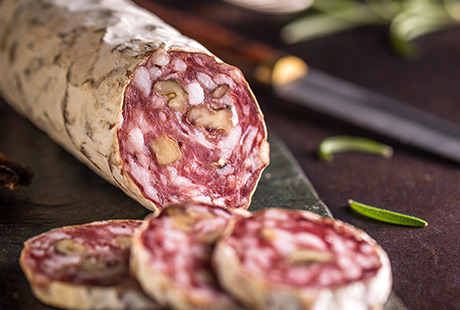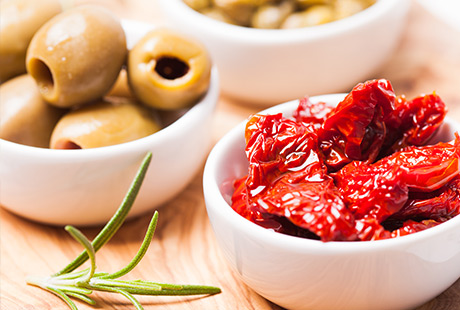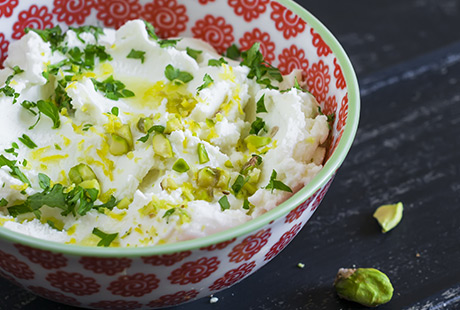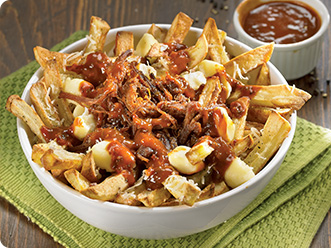- 4 Québec products to add to your recipes
- 10 Ways to Eat More Fruit Every Day
- Brighten up Your Plate with Citrus Fruit
- 12 Fresh Five-Star Salads
- Discover Hot and Sweet Peppers
- Eat More Nuts
- Enjoy Locally Grown Vegetables Year-Round
- Ways to Use Garden Vegetables
- Ketchups, Relishes, Chutneys, Marinades and Aromatic Vinegars
- Cranberries
- Cook with potatoes
- 8 Easy Recipes to Prepare Pumpkin—Differently
- Eat your veggies from the leaves to the roots
- Rediscover Fries!
- Super Salads!
- Eat more chickpeas
- Fruits and vegetables on the barbecue
- Apples on the menu
Cook with potatoes

Potatoes have been a basic food in the Andes for over 7,000 years. During the Incan Empire, the emperor would store potatoes so that he could distribute them to farmers during the famines.
Potatoes were introduced in Europe by the Spaniards at the beginning of the 16th Century, but it was not until the end of the 18th Century that large-scale cultivation began on the Continent and in Great Britain.
How to Make Vegetable and Potato Curry
Savour our potato recipes
Ideas to jazz up your mashed potatoes

Chopped citrus zests

Diced dried sausage and freshly chopped oregano

Some olives and dried tomatoes for Mediterranean-style mashed potatoes

Mascarpone cheese and fresh herbs
How to make perfect mashed potatoes
1Start by peeling, dicing and boiling the potatoes a little longer than you normally would for regular potatoes. The potato must crumble easily; that’s what ensures a smooth finish.
2Next, mash the potatoes with a pestle or potato ricer instead of a mechanical arm. Electrical appliances usually make your mashed potatoes sticky because the rapidity of the mashing motion releases the starch from the potatoes. This is what causes the glue-like finish. Try to avoid them if you can.
3Add milk and butter to taste. Some say adding warm milk gives an even better result. Try it, and you be the judge!
Some original poutine combinations
| Sauce | Cheese | Topping |
| Beef Gravy | Brie Cheese | Ham |
| Beef Gravy | Swiss Cheese | Bacon and Carmelized Onions |
| Peppercorn Sauce | Grated Cheddar | Filet Mignon Strips |
| Exclusive Metro Mushroom Sauce | Cheese Curds | Chicken Strips |
| Spaghetti Sauce | Parmesan | Smoked Meat |
Feel like poutine?

Metro offers ready-to-serve gourmet sauces in store! For your poutine, try our bistro-type gravy sauce with a hint of pepper, onion and red wine. Add some leftover pulled braised beef, a few chunks of squeaky cheese curds and you’ve got yourself a poutine fit for the finest restaurants around.
You can do more with potatoes!

Here are some tips to add potatoes to your stews and braised dishes:
- Add potatoes halfway through cooking when braising; this way they’ll absorb all the taste from the liquid.
- Add them peeled if you want them to absorb the liquid or leave them with theirs skins if you want a firmer texture and have them keep their shape throughout cooking.
- For braising, choose medium sized baby potatoes.
- For stewing, choose Russet potatoes since they keep their shape longer.
- To add texture to your stews and braised dishes, add potatoes at the start of cooking. They’ll disintegrate during cooking and thicken the sauce at the same time.
Braised, stewed or boiled
We often ask ourselves what the difference is between these three cooking methods!
- Braised: Meat cooks covered over a long period of time at low heat, in a little seasoned liquid.
- Stewed: Meat cooks slowly in a covered pot and is totally immersed in liquid.
- Boiled: Meat cooks in boiling liquid that remains at a gentle boil throughout cooking.





















